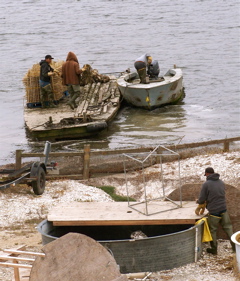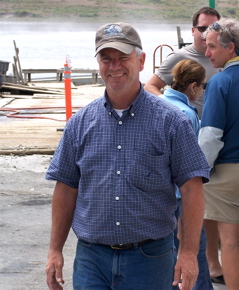Thu 7 May 2009
Scientists find no evidence oyster farm harming Drakes Estero; more likely restoring it
Posted by DavidMitchell under General News, Inverness, Marin County, West Marin nature
Comments Off on Scientists find no evidence oyster farm harming Drakes Estero; more likely restoring it
The National Research Council on Tuesday released a report which found “a lack of strong scientific evidence that the present level of oyster-farming operations by Drakes Bay Oyster Company has major adverse effects on the ecosystem of Drakes Estero.”
Notwithstanding Park Service statements, oyster growing appears to instead provide a significant environmental benefit, the council’s report concluded. An announcement of the 100-page report’s release noted, “To some extent, the oysters in Drakes Estero replace the filtering and material processing that was lost more than a hundred years ago when the native Olympia oysters were over-harvested.”
 In 2007, Marin County supervisors asked Senator Dianne Feinstein (right) to intervene after the Point Reyes National Seashore administration began harassing the oyster company.
In 2007, Marin County supervisors asked Senator Dianne Feinstein (right) to intervene after the Point Reyes National Seashore administration began harassing the oyster company.
That July, Feinstein responded by convening a meeting in West Marin attended by top Park Service officials, oyster company owner Kevin Lunny, Marin County Supervisor Steve Kinsey, and others.
As a result of the meeting, Lunny was allowed to get some permits he needed, and the Park Service agreed to finance a National Research Council study of whether oyster cultivation in Drakes Estero was, in fact, doing any environmental damage, as the park had been claiming.
(The National Research Council, along with the National Academy of Sciences, National Academy of Engineering, and Institute of Medicine make up the national academies. They describe themselves as “independent, nonprofit institutions that provide science, technology, and health policy advice under an 1863 congressional charter.”)
 The conflict began with an ideological shift within the Park Service over the past 12 years, which led to a decision to close the oyster company.
The conflict began with an ideological shift within the Park Service over the past 12 years, which led to a decision to close the oyster company.
In an attempt to build public support for the decision, the National Seashore administration three years ago began publicly accusing the company of doing environmental damage.
But it was mostly hogwash. An October 2006 park report titled A Sheltered Wilderness Estuary contained so many misleading statements (some of which were caught by the scientists it cited) that the park had to keep posting revised versions online, four in all, along with two “correction” and “clarification” postings.
Commenting on the National Seashore’s maligning the oyster company, the National Research Council wrote, “In several instances, the agency selectively presented, over-interpreted, or misinterpreted the available scientific information on potential impacts of the oyster mariculture operation.”
Comments such as these in the report prompted The San Francisco Chronicle on Wednesday to note, “The findings mark the second time in a year that the Park Service has been put under the spotlight for essentially fudging data in its attempts to show that the Drakes Bay Oyster Company harmed the environment.”
 The first exposure occurred in July 2008 when the Inspector General’s Office of the Interior Department issued a report that concluded National Seashore Supt. Don Neubacher and his senior science advisor had misled county officials and the public about the oyster company’s effect on seals, eelgrass, and sedimentation.
The first exposure occurred in July 2008 when the Inspector General’s Office of the Interior Department issued a report that concluded National Seashore Supt. Don Neubacher and his senior science advisor had misled county officials and the public about the oyster company’s effect on seals, eelgrass, and sedimentation.
Oyster company owner Kevin Lunny (right) under siege from a park administration that doesn’t play by the rules.
After the National Research Council report was issued this week, Senator Feinstein wrote Interior Secretary Ken Salazar, “I find it troubling and unacceptable that the National Park Service exaggerated the effects of the oyster population on the… ecosystem,” The Chronicle reported.
However, The Chronicle also quoted Neubacher’s boss Jon Jarvis, director of the Pacific West Region of the Park Service, as saying he still won’t extend the oyster company’s use permit for its onshore facilities when the permit comes up for renewal in 2012.
 “That really is a policy and law issue,” said Jarvis (right), “not a science issue.”
“That really is a policy and law issue,” said Jarvis (right), “not a science issue.”
Which begs the question: if it’s not a science issue, why did the park administration go to such lengths to misrepresent science in its dispute with the oyster company?
As for the policy and legal issue, Jarvis is relying on the opinion of a field solicitor in the San Francisco Field Office, who says the bottomlands of the estero can be designated federal wilderness despite state government’s retaining fishing (including aquaculture) rights over them.
In 1976, then-Assistant Interior Secretary John Kyle told Congress the wilderness bill they were about to pass could not include the estero’s bottomlands because the state owned them. Now we have a presumptuous federal lawyer in San Francisco saying that the Assistant Secretary of the Interior Department and his legal staff got it all wrong and that he, in his outlying field office on the West Coast, knows better.
Assistant Secretary Kyle’s written statement to Congress was “inaccurate,” field solicitor Ralph Mihan has decided, and Congress’ new concept of “potential wilderness” overrode it anyhow.
However, attorney Mihan wrote this opinion in 2007 during the Bush Administration, and in it he acknowledged his reasoning was based not only on law but also on “present-day National Park Service director’s orders and management policies.”
In short, the oyster company is haunted by the ghost of the Bush Administration’s Park Service.

No Responses to “ Scientists find no evidence oyster farm harming Drakes Estero; more likely restoring it ”
Sorry, comments for this entry are closed at this time.